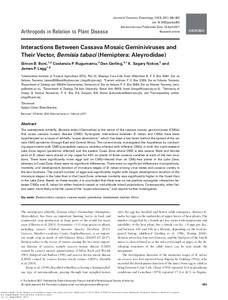| dc.contributor.author | Boni, S.B. |
| dc.contributor.author | Rugumamu, C.P. |
| dc.contributor.author | Gerling, D. |
| dc.contributor.author | Nokoe, K.S. |
| dc.contributor.author | Legg, J.P. |
| dc.date.accessioned | 2019-12-04T11:10:42Z |
| dc.date.available | 2019-12-04T11:10:42Z |
| dc.date.issued | 2017 |
| dc.identifier.citation | Boni, S.B., Rugumamu, C.P., Gerling, D., Nokoe, K.S. & Legg, J.P. (2017). Interactions between cassava mosaic geminiviruses and their vector, Bemisia tabaci (Hemiptera: Aleyrodidae). Journal of Economic Entomology, 110(3), 884-892. |
| dc.identifier.issn | 0022-0493 |
| dc.identifier.uri | https://hdl.handle.net/20.500.12478/2240 |
| dc.description | Published online:18 April 2017 |
| dc.description.abstract | The sweetpotato whitefly, Bemisia tabaci (Gennadius) is the vector of the cassava mosaic geminiviruses (CMGs) that cause cassava mosaic disease (CMD). Synergistic interactions between B. tabaci and CMGs have been hypothesized as a cause of whitefly “super-abundance,” which has been a key factor behind the spread of the severe CMD pandemic through East and Central Africa. The current study investigated this hypothesis by conducting experiments with CMD-susceptible cassava varieties infected with different CMGs in both the north-western Lake Zone region (pandemic affected) and the eastern Coast Zone where CMD is less severe. Male and female pairs of B. tabaci were placed in clip cages for 48 h on plants of three cassava varieties at each of the two locations. There were significantly more eggs laid on CMG-infected than on CMG-free plants in the Lake Zone, whereas in Coast Zone, there were no significant differences. There were no significant differences in proportions, mortality, and development duration of immature stages of B. tabaci among virus states and cassava variety in the two locations. The overall number of eggs was significantly higher with longer development duration of the immature stages in the Lake than in the Coast Zone, whereas mortality was significantly higher in the Coast than in the Lake Zone. Based on these results, it is concluded that there was no net positive synergistic interaction between CMGs and B. tabaci for either lowland coastal or mid-altitude inland populations. Consequently, other factors seem more likely to be the cause of the “super-abundance,” and require further investigation. |
| dc.format.extent | 884-892 |
| dc.language.iso | en |
| dc.subject | Bemisia Tabaci |
| dc.subject | Cassava |
| dc.subject | African Cassava Mosaic Virus |
| dc.subject | Geminiviruses |
| dc.subject | Development Duration |
| dc.subject | Sweetpotato Whitefly |
| dc.title | Interactions Between Cassava Mosaic Geminiviruses and Their Vector, Bemisia tabaci (Hemiptera: Aleyrodidae) |
| dc.type | Journal Article |
| dc.description.version | Peer Review |
| cg.contributor.crp | Climate Change, Agriculture and Food Security |
| cg.contributor.crp | Genebanks |
| cg.contributor.crp | Roots, Tubers and Bananas |
| cg.contributor.affiliation | International Institute of Tropical Agriculture |
| cg.contributor.affiliation | University of Dar es Salaam |
| cg.contributor.affiliation | Tel Aviv University |
| cg.contributor.affiliation | University of Energy and Natural Resources, Ghana |
| cg.coverage.region | Africa |
| cg.coverage.region | East Africa |
| cg.coverage.country | Tanzania |
| cg.isijournal | ISI Journal |
| cg.authorship.types | CGIAR and developing country institute |
| cg.iitasubject | Cassava |
| cg.iitasubject | Pests Of Plants |
| cg.journal | Journal of Economic Entomology |
| cg.howpublished | Formally Published |
| cg.accessibilitystatus | Limited Access |
| local.dspaceid | 90987 |
| cg.targetaudience | Scientists |
| cg.identifier.doi | http://dx.doi.org/10.1093/jee/tox064 |

